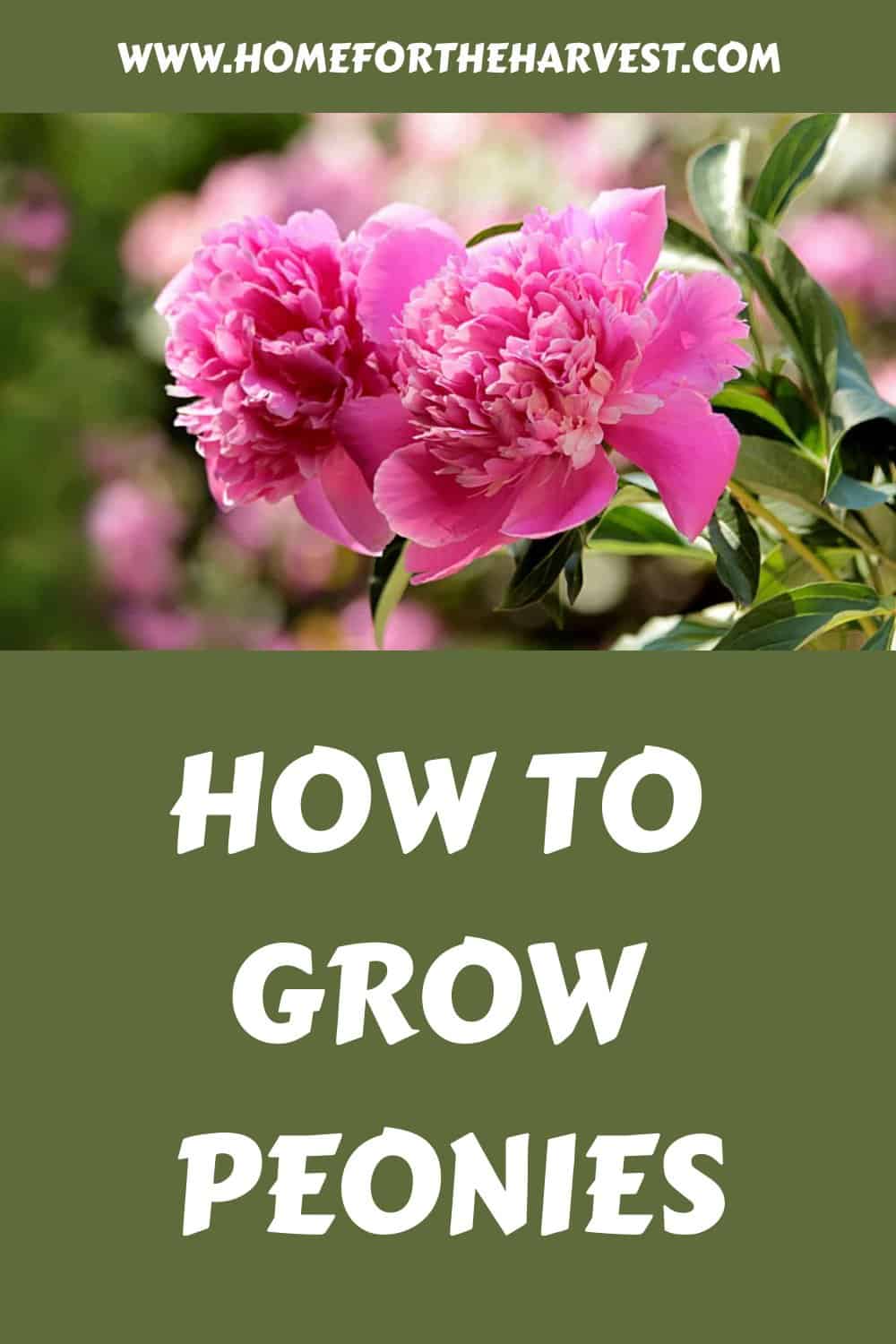Grow peonies for a gorgeous garden! Whether you’re looking to add some charm and beauty or simply want to make your outdoor space, look even more amazing, growing peonies is a perfect way. Not only do they provide vibrant colors in shades of pink, white and red, but they are also easy to take care of if you know what you’re doing.
Learn how with these helpful tips on planting, watering, fertilizing, pruning, pest control, and problem-solving – so that all your hard work will be rewarded with lush blooms every spring!

How to grow peonies
Peony plants are a beautiful and fragrant addition to any garden. They can thrive for many years in your yard or flower bed with the right care. Here’s what you need to know about planting, watering, fertilizing, pruning, and pest control for peony plants.
There are quite a few different types of peonies and thousands of individual varieties (cultivars) to choose from. You can search locally for rare peonies, but starting with a few of the most popular peony varieties usually makes sense. Colors like pink peonies and white peonies are very popular, but there are also now some purple, red, and even yellow cultivars available at garden centers. pink peonies
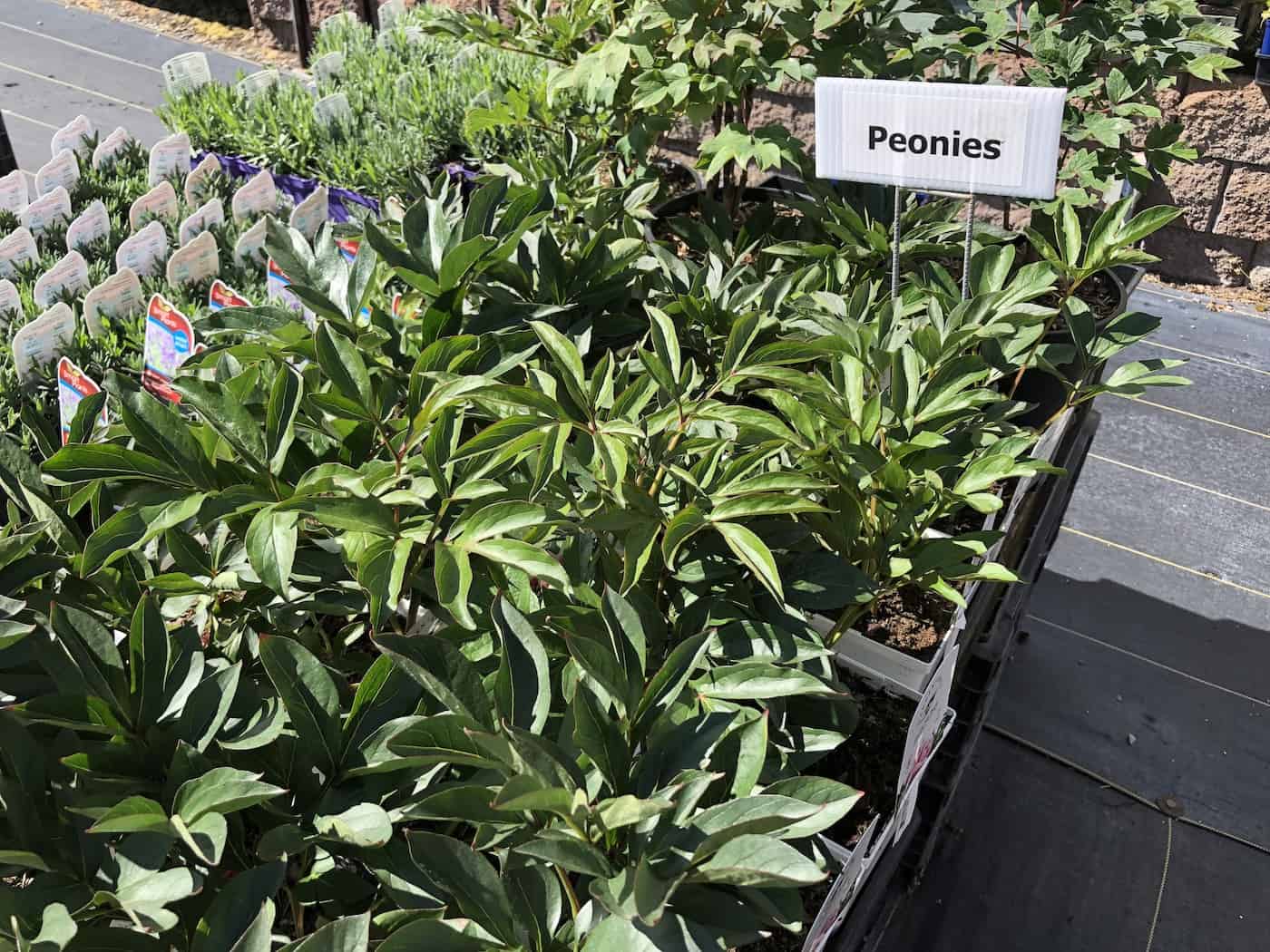
Growing peonies is best done in early spring or late fall when temperatures are cooler. Choose an area with a well-draining soil surface that gets full sun during the day. Dig a hole twice as wide as the root ball of your plant and mix some compost into the soil before backfilling it around the peony roots of your new peony plant. Water thoroughly after planting to help settle the soil surface around its roots.
Once established, water your peony plants deeply once per week during dry spells throughout their growing season (April through August). Make sure not to over-water them; too much moisture can cause root rot and other diseases that will damage or kill your plants if left unchecked.
Fertilize peony plants with a balanced fertilizer in the spring when the stems are about a foot high and are about to leaf out. After this point, you should stop fertilizing.
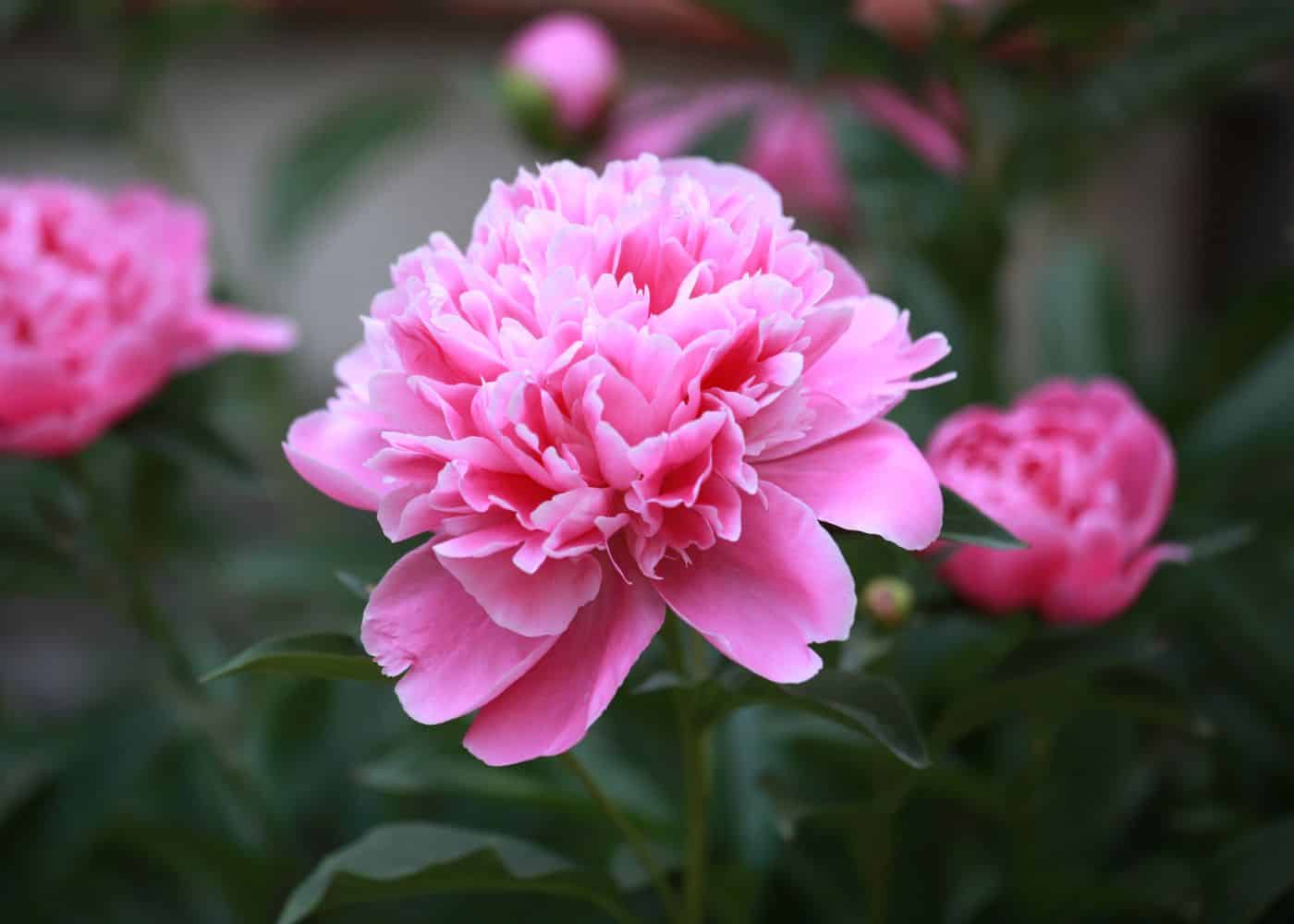
Prune off dead foliage from last year’s growth at ground level each spring before new shoots emerge from underground rhizomes (peony roots) – this will help encourage healthy new growth each year. If desired, you may also lightly trim away spent flowers after they have finished blooming, but make sure not to cut into green foliage while doing so as this could damage future bud development further down stem branches in summer months ahead of time.
Monitor closely for signs of pests such as aphids or Japanese beetles, which may feed upon leaves and flowers if left unchecked. Use insecticidal soap sprays if necessary, but try natural methods first, like introducing beneficial insects into garden beds near affected areas whenever possible.
Common problems include powdery mildew, which appears white on leaf surfaces due to lack of air circulation caused by overcrowded gardens – remove excess foliage surrounding affected areas, then treat with fungicide spray accordingly afterwards.
Another common issue is crown rot caused by overly wet soils leading up towards winter months ahead – ensure proper drainage within beds prior, then mulch heavily afterward using organic matter like wood chips or composted yard trimmings.
Finally, enjoy all those gorgeous peony blossoms come summertime by cutting some fresh bouquets indoors where petals won’t be damaged by outdoor elements like wind and rain. It inevitably always seems to rain just as the peonies are opening (groan!). You can pick all the peonies off one plant if you like. They will spend the rest of the summer setting up next year’s flower buds.
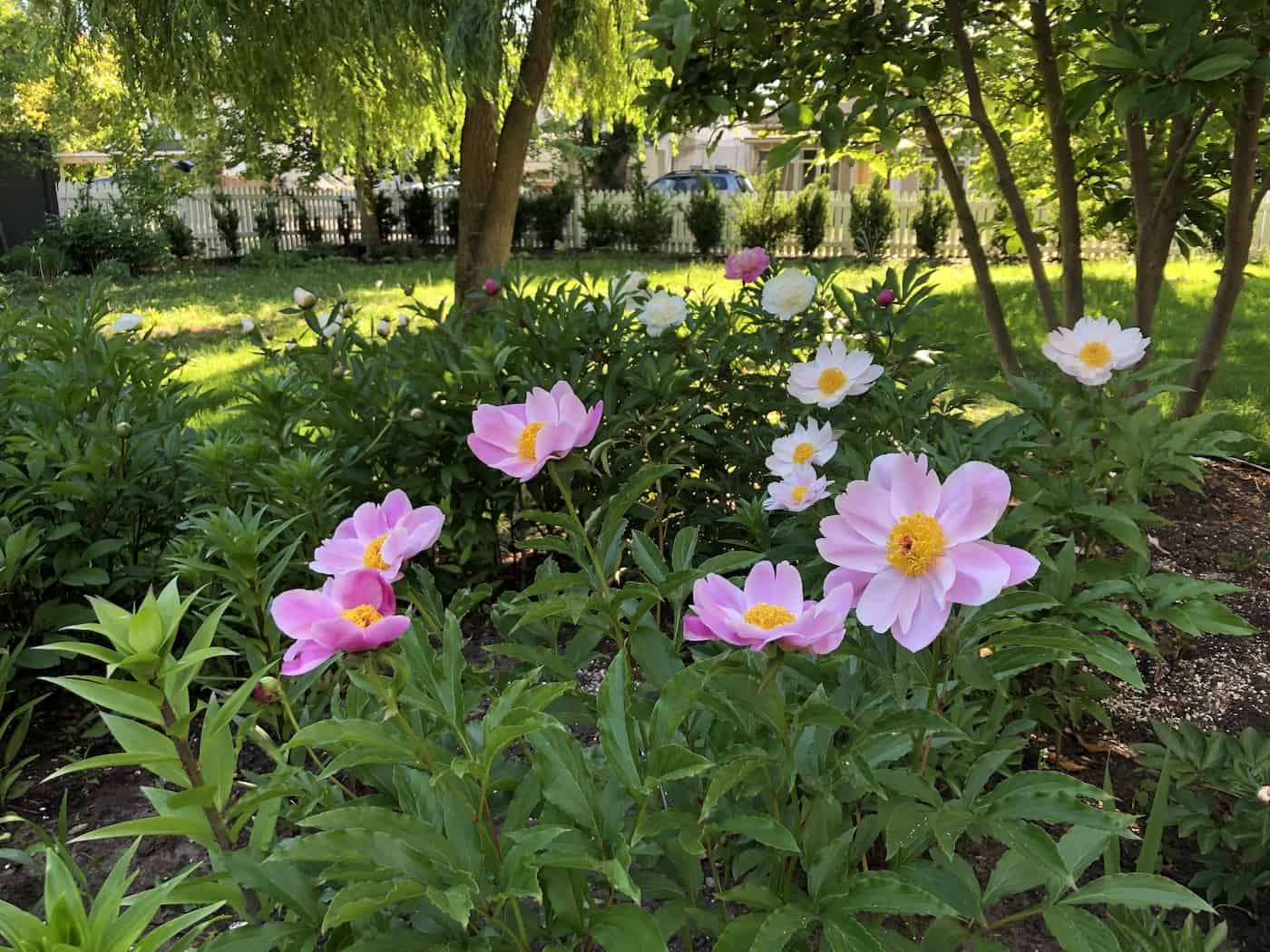
Ideal growing conditions for peony plants
Planting peonies in full sun is ideal, with at least 6 hours of direct sunlight per day being necessary for them to bloom properly.
Morning sun is preferable to afternoon sun as it can help protect the flowers from wilting due to heat stress. Peonies also need well-drained soil that isn’t too windy or exposed, as this could cause their blooms to be damaged by strong winds or drying out quickly.
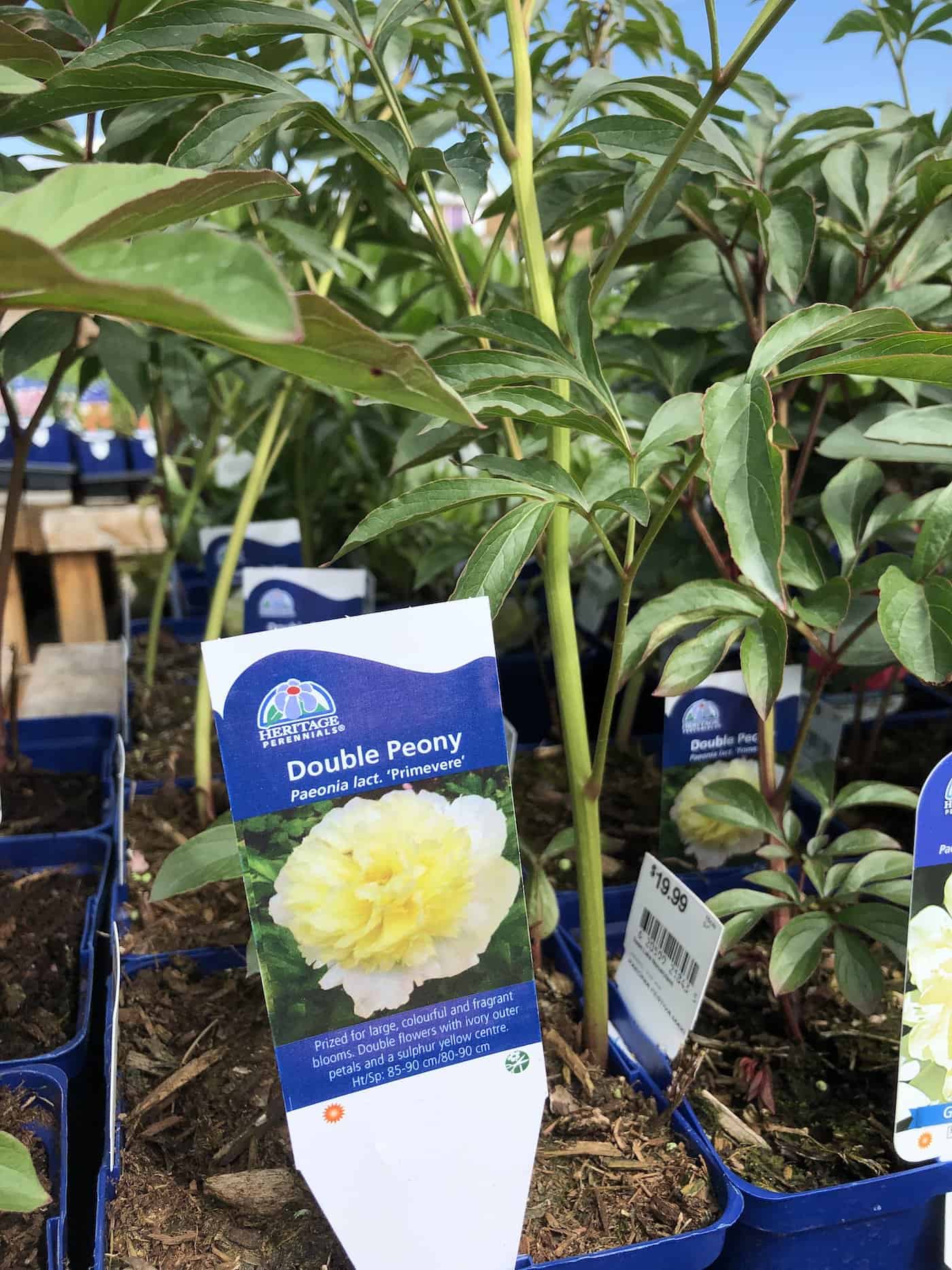
Planting peonies
Planting peonies is best done in the fall when temperatures are cooler and soil is still warm. You can also plant peonies in spring. Bare-root peonies are usually planted in early spring, while potted plants with leaves are planted once the soil warms up.
Peonies prefer a sunny spot with well-drained, loamy soil with a pH of 6.5 to 7.0. When planting, it’s important to give them enough space for their roots to spread out and grow properly; plant each about 3 feet apart from the next.
Dig a hole twice as wide as the root ball and just deep enough so that the eyes (flower buds) on top of the crown are at or slightly above ground level once planted. You should be able to see the peony buds.
Place your peony in its new home, backfill with dirt, tamp down gently but firmly around it, then water thoroughly until moistened throughout all of its roots.
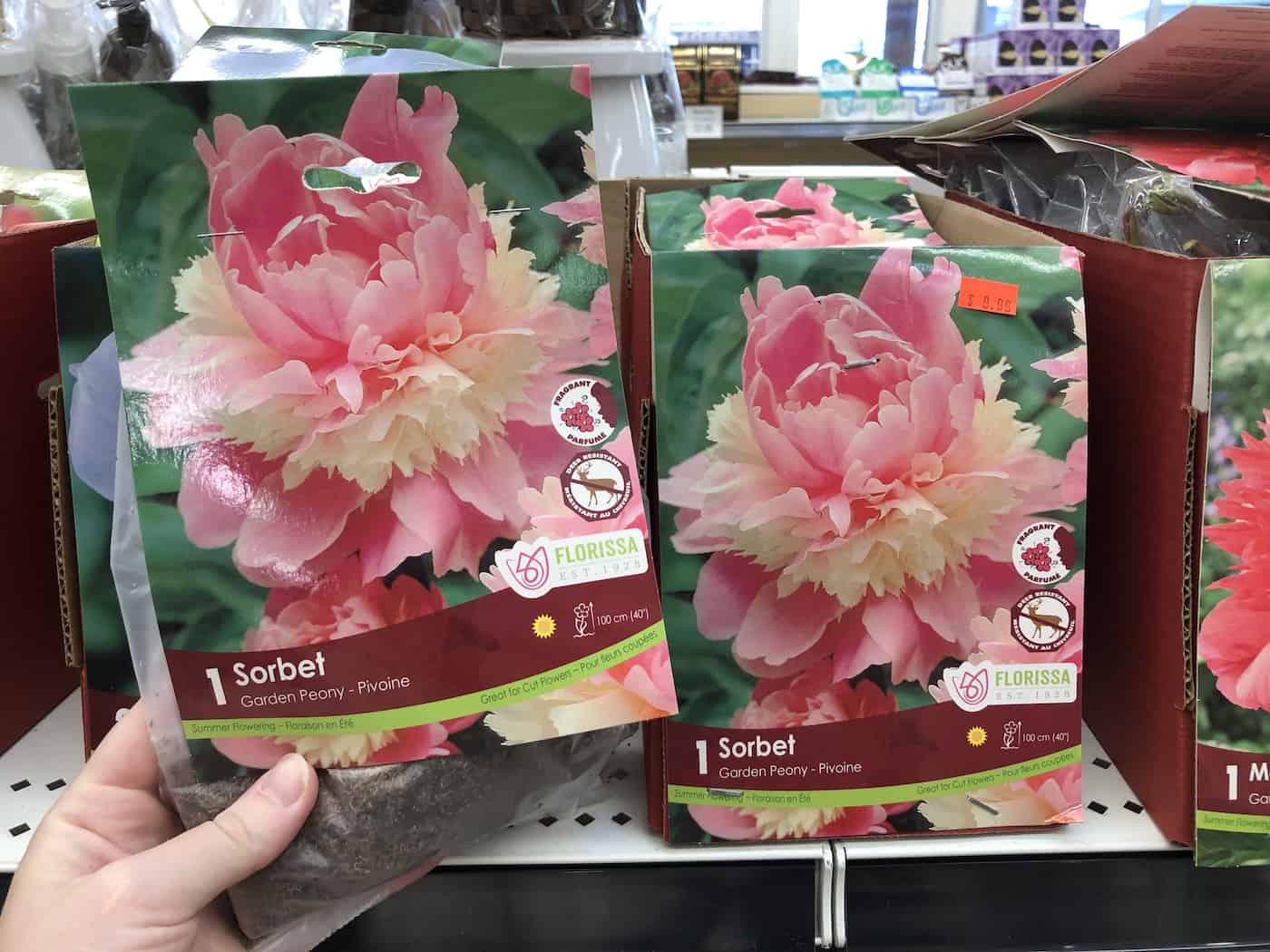
If you are planting a bare-root peony, dig the hole quite wide and shallow so that the “eyes” of the root are about an inch below the soil line. Backfill with a mix of compost and soil. Space your peonies 18-24 inches apart and water them well after planting. Peonies bloom within 2-3 years.
When planting bare-root peonies, add mulch over the top of the soil after you’ve planted and watered. This will help keep weeds away and also help retain moisture during dry spells – make sure not to pile mulch up against the stems. With proper care, you should have beautiful blooms come springtime.
When growing peonies, it is important to consider the location and soil type to ensure they thrive. Now that you have the basics down let’s look at how to water your peonies properly for optimal growth.
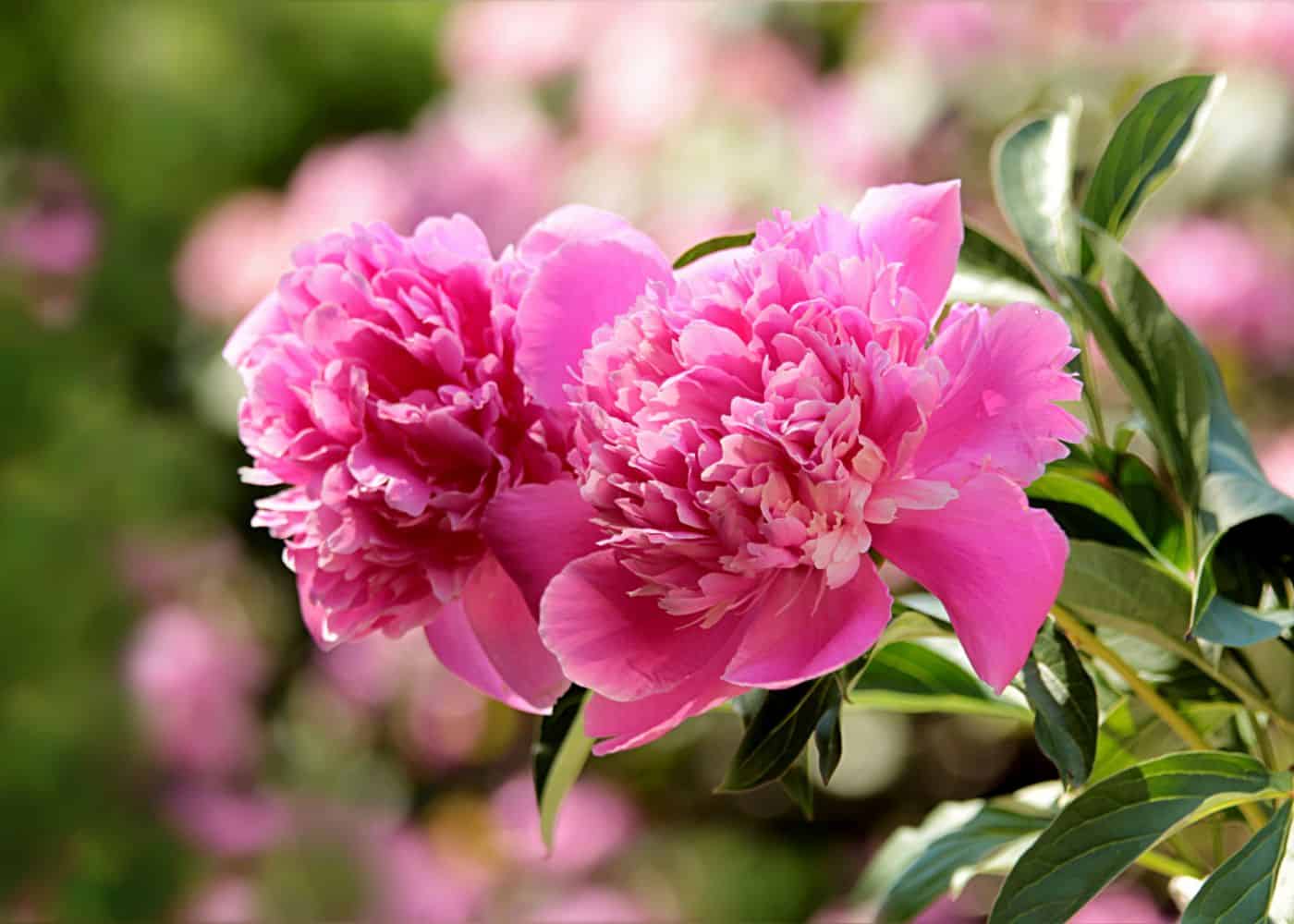
Watering peony plants in the garden
Watering peonies is an important part of caring for these beautiful plants. Peonies require regular watering, but not too much or too little. The amount of water they need depends on your area’s climate and soil type. Generally speaking, peonies should be watered deeply once a week during dry periods and when temperatures are high.
It’s best to use drip irrigation or soaker hoses to provide deep, slow-release moisture directly to the roots without wetting the foliage, which can lead to fungal diseases like powdery mildew. If you’re using a sprinkler system, make sure it’s set up correctly so that it doesn’t spray water onto the leaves and flowers of your peony plants.
You’ll know if your peony needs more water if its leaves start wilting or drooping down towards the ground; this is usually a sign that it needs some extra hydration. On the other hand, overwatering can cause root rot and other issues with plant health as well as encouraging weed growth around them due to excess moisture in their environment. newly planted peonies
When you water your peonies, ensure that you give them enough time between each session for their soil to dry out completely before adding any additional moisture again – this will help prevent root rot from occurring due to overly damp conditions around their roots.
Additionally, mulching around your plants can help retain moisture levels in their immediate vicinity while also providing protection against weeds competing for resources such as light and nutrients from nearby sources like grasses or trees growing close by.
Proper watering practices are essential for keeping healthy and happy peony plants. With just a bit of effort every week or two, you can enjoy gorgeous blooms all season long.
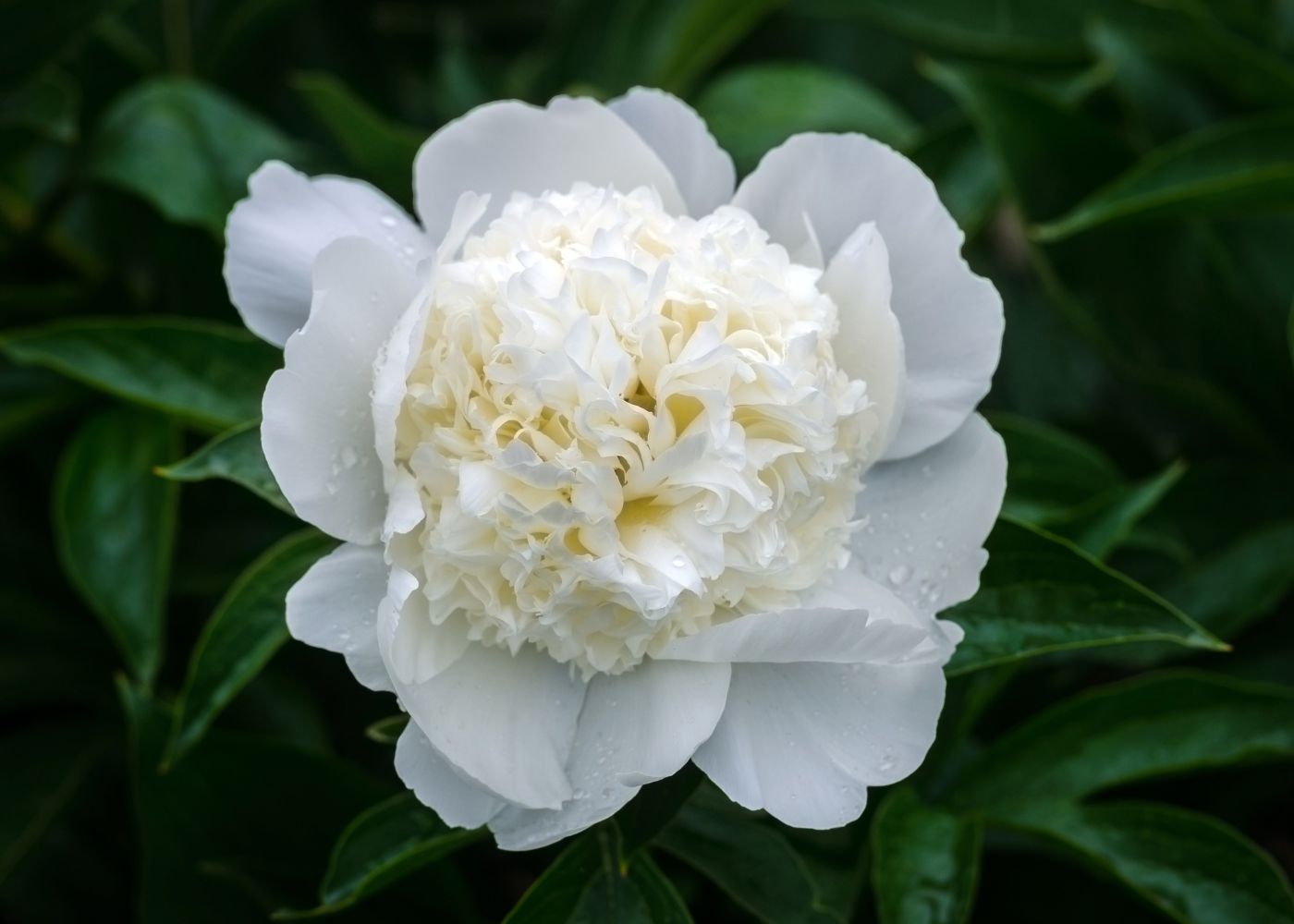
Fertilizing peony plants
Fertilizing peonies is an important part of their care. Peonies need fertilizer to grow and bloom properly, so giving them the nutrients they need for healthy growth is essential. herbaceous peony herbaceous peony divide herbaceous peonies
When fertilizing peonies, use a balanced fertilizer that will provide your plants with all the necessary nutrients for optimal growth. It’s best to apply the fertilizer in early spring when new shoots are emerging from the soil and are about a foot high.
The amount of fertilizer you should use depends on how large your plant is and what kind of soil it’s growing in. If you have sandy or loamy soils, you can use more than clay soils because these types don’t hold onto nutrients as well as other soils do. Generally speaking, one cup per square foot should be enough for most plants.
You can also add organic matter such as compost or manure to help boost nutrient levels in your soil before growing peonies or at any time during their growing season. Organic matter helps improve drainage and aeration while providing additional nutrition that may not be found in synthetic fertilizers alone.
It’s important not to overfertilize peony plants since too much nitrogen can cause excessive leafy growth instead of flowers blooming on stems as they should. Too much nitrogen also encourages disease problems which could kill off your entire crop if left unchecked. Be sure to follow directions carefully when applying any type of synthetic or organic fertilizer – less is often better than more when it comes to fertilizing.

Pruning peony plants
Pruning is an important part of caring for peonies. It helps to promote healthy growth and encourages the plant to produce more flowers. Pruning should be done in the fall, late winter, or early spring when the plants are still dormant. This will help prevent any damage from cold weather that may occur during pruning.
Cut back all of the stems so they’re a few inches above ground level. Make sure you use sharp gardening shears or scissors to avoid ripping the stems while cutting them back.
Once you have finished pruning your peony bush, spread some mulch around its base to protect it from extreme temperatures and conserve moisture in its soil over time. This will also give it a neat appearance. Following these steps each year, you can enjoy beautiful blooms on your peony bushes every summer.
Pest control for peony plants
Pests can be a major problem for peony plants, but you can keep your plants healthy and thriving with the right preventative measures and treatments.
Aphids are one of the most common pests that affect peonies. These small insects feed on plant sap, causing leaves to curl and become distorted. Regularly check your plants for signs of damage or discoloration to prevent aphid infestations. If you find any evidence of an infestation, treat it immediately with insecticidal soap or neem oil spray.
Mealybugs are another pest that may attack peonies. These tiny white bugs suck the sap from stems and leaves, which causes them to turn yellow and die off prematurely. To control mealybug populations in your garden, use a cotton swab dipped in rubbing alcohol to remove them from affected areas as soon as possible before they spread further throughout the plant’s foliage. You can also apply horticultural oils or insecticidal soaps directly onto affected parts of the plant if necessary.
Spider mites are another pest that loves feasting on peony foliage and flowers. They create webs between stems, making it easy to spot their presence early on before too much damage is done to your beloved blooms. The best way to get rid of spider mites is by using a strong jet stream of water directed at both sides of each leaf every few days until all signs have disappeared completely; this should help reduce their numbers significantly over time without having to resort to chemical treatments such as pesticides or miticides.
Slugs & snails often feast upon tender new growth found near soil level; these slimy critters will leave behind silvery trails along stem bases while they snack away at young shoots overnight. To discourage slugs & snails from dining out in your garden beds, try sprinkling diatomaceous earth around base areas where these creatures tend to congregate – this natural powder-like substance works wonders when used correctly against many types of crawling pests, including slugs & snails. Additionally, handpicking any visible offenders during daylight hours helps, too (just make sure not to touch them directly).
Finally, Japanese beetles love nothing more than feasting upon beautiful petals. If left unchecked, these metallic green bugs will quickly devour entire flower heads, leaving only bare stalks in their wake. The best way to deal with Japanese beetle invasions is by using traps baited specifically for them; alternatively, applying Neem oil-based sprays onto affected areas has proven effective against adult beetles as well as larvae stages present within soil beds nearby too.
Common problems and solutions
The most common problems with peony plants include root rot, powdery mildew, and damage from late spring frosts.
Root rot
Root rot is a common problem with peonies, caused by the fungus Phytophthora. Symptoms include wilting and discoloration of leaves, stunted growth, and poor flowering. To prevent root rot, make sure your soil has good drainage and avoid overwatering. If you suspect root rot in your plants, remove affected roots and treat the plant with fungicide to stop the further spread of the disease.
Powdery mildew
Powdery mildew is a fungal disease that affects many types of plants, including peonies, causing white spots on foliage, which can eventually lead to leaf drop if left untreated. To reduce the risk of powdery mildew developing on your plants, keep them well-watered during dry spells, but don’t over-water them as wet conditions encourage the development of fungi such as powdery mildew. Prune away any infected parts immediately and apply an appropriate fungicide treatment according to the instructions provided on the packaging.
Frost damage
Peonies are hardy perennials but can be damaged by frost or cold temperatures if coddled container plants are planted too early in spring before the last frost date for your area. Frost damage appears as blackened flower buds or stems that have been killed off due to exposure to cold weather. To prevent this from happening, wait until after the danger of frost has passed before planting new potted peonies grown in nurseries outdoors in springtime.
Enjoying peonies
When it comes to enjoying your peonies, the possibilities are endless. From cut flower arrangements to landscaping projects, you can find a way to incorporate these beautiful blooms into your home.
Creating cut flower arrangements
Peonies make stunning additions to any bouquet or centerpiece. Cut them when they’re in full bloom and enjoy their beauty indoors for up to two weeks. When cutting the stems, be sure to use sharp scissors or pruners and cut at an angle so that more surface area is exposed for water absorption. Keep the flowers away from direct sunlight and drafts of air for best results.
Landscaping projects featuring peonies
If you have a garden bed dedicated solely to peonies, consider adding other plants around them, such as hostas or daylilies, for contrast in texture and color. There are many different low-maintenance plants that make excellent companion plants for peonies, including lilies, roses, and certain types of hydrangeas.
You can also create pathways with stepping stones leading up towards the center of your garden bed where all of your peony plants will be located – this will add dimension and depth while making it easier for you (and others) to admire their beauty without having to trample on them.
Container gardening with peonies
Container gardening is another great way of enjoying your peonies if you don’t have much space outdoors or want something more portable than a traditional garden bed setup. Choose large enough containers so that each plant has plenty of room but not too big where they won’t get adequate drainage. Clay pots work well since they absorb excess moisture, which helps keep roots healthy during hot summer days. Make sure there are several holes at the bottom before planting anything inside, then fill the pot with soil mixed with compost and fertilizer according to package instructions before adding any plants or seeds.
Dried peony flowers
Drying out freshly cut blooms is another creative way of displaying them year-round throughout your home. Gather several stems together using twine, then hang them upside down in a cool, dry place until completely dried out; this usually takes about two weeks. Once done, arrange them however desired in vases or baskets as decorations around different rooms.


